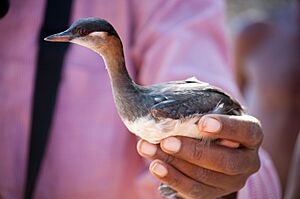Madagascar grebe facts for kids
Quick facts for kids Madagascar grebe |
|
|---|---|
 |
|
| Conservation status | |
| Scientific classification | |
| Genus: |
Tachybaptus
|
| Species: |
pelzelnii
|
The Madagascar grebe (Tachybaptus pelzelnii) is a special type of grebe bird. You can only find it in western and central Madagascar, which is a large island country. This bird's scientific name, pelzelnii, honors an Austrian bird expert named August von Pelzeln. Sadly, the Madagascar grebe is an endangered bird. There are fewer than 5,000 of them left. They are in danger because their homes are disappearing, big fish are eating them, and new animals brought to Madagascar are competing with them for food and space.
Contents
What Does the Madagascar Grebe Look Like?
The Madagascar grebe is a small bird, about 25 cm (10 inches) long. That's about the length of a ruler! When these birds are ready to breed, they have special colors. They get a dark cap on their head and a dark line down their neck. The back of their ears and sides of their neck often turn reddish. Their cheeks, throat, and the front of their neck are a light gray color. Some birds even have a thin white line under their eye.
Where Do Madagascar Grebes Live?
You can find the Madagascar grebe all over western and central Madagascar. They often live near lakes. In the late 1990s, experts found these birds in 25 important bird areas across Madagascar. However, their numbers are quickly going down.
For example, on Lake Alaotra, there were hundreds of these birds in 1985. By 1993, there were only 10 to 20 left. And by 1999, none were found there at all! Today, there might be as few as 1,500 to 2,500 Madagascar grebes left in total.
These grebes usually like shallow, freshwater lakes and ponds. They especially like places with lots of lily pads. But sometimes, they are also found in much deeper lakes. They have even been seen near slightly salty water and slow-moving rivers.
What Do Madagascar Grebes Eat and How Do They Live?
The Madagascar grebe mostly eats insects. But they also enjoy small fish and tiny crustaceans, like shrimp. These birds usually stay in one place. However, they will move if they need to find a better home.
Their breeding season can last from August to March. Usually, a pair of grebes will claim their own area for nesting. But sometimes, large groups of up to 150 birds have been seen nesting together! They build their nests on floating piles of water plants. These nests are usually tied to plants in the water, like waterlilies.
Why Are Madagascar Grebes in Danger?
The Madagascar grebe is currently listed as a vulnerable bird by the IUCN. This means they are at high risk of becoming endangered.
One of the biggest dangers is that their natural homes are being destroyed. People are turning wetlands into farms to grow rice and other crops. Also, new types of fish brought to Madagascar are causing problems. For example, at Lake Alaotra, big, meat-eating snakehead fish eat the adult grebes.
The grebes can also get caught in fishing nets made of thin plastic. Another problem is the introduction of plant-eating fish, like Tilapia zillii. These fish eat the water plants that the grebes need for food and nesting. This also helps the Little Grebe (T. ruficollis) to thrive, which then competes with the Madagascar grebe. Both species are considered vulnerable.
More and more, farmers are using pesticides and fertilizers. These chemicals can harm the freshwater ecosystems in Madagascar, which also hurts the grebes. Experts believe the number of grebes will keep dropping quickly. This is because wetlands continue to be changed and too much fishing happens. This leaves the grebes with fewer safe places to live.
How Are We Protecting Madagascar Grebes?
Good news! People are working to help the Madagascar grebe. These birds have been seen in six protected areas. To decide which wetlands need protection the most, a plan has been suggested. This plan uses birds, especially the Madagascar grebe, as a sign of how healthy the wetland is.
The government of Madagascar has also agreed to the Ramsar Convention. This is an international agreement to protect wetlands. This will likely help improve efforts to save wetlands and start special studies to understand why this bird's numbers are falling.


